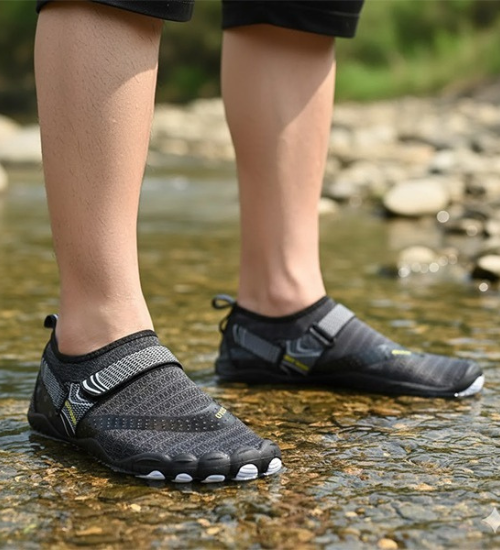We have always had a philosophy at Andune that body and performance start from the ground up. To athletes, every step matters - the way the foot strikes, how it pushes off, and how it interacts with the surface below. One trend that we’ve seen take off over the years in the sports and fitness world is a shift towards barefoot running footwear; again, these are not just shoes or a trend, but rather a different way of moving together with a focus on natural movement, strength, and control.
What is Barefoot-Style Running?
Barefoot-style running is all about mimicking the natural running mechanics of the body without the use of cushioning and structure like traditional shoes. Traditional style shoes usually encourage a heel-strike running pattern, whereas barefoot running footwear will naturally promote a more mid-foot or forefoot landing. When running barefoot or near-barefoot, many athletes report a stronger sensation of feeling more connected to the ground while being more mindful about each step taken.
For most athletes, this shift can be an eye-opener. It is not meant to replace every shoe in the training rotation; it is simply a new tool to add to the training tool kit to promote body awareness and foot engagement.
Why Are Athletes Choosing to Use Barefoot Footwear?
When we initially evaluated barefoot shoes, we were surprised at how much was being asked of the feet. Barefoot footwear does tap into more of the foot's musculature because they are lighter and more flexible, allowing muscles to fire that are not much used in a regular shoe, and over time, could help facilitate greater foot stability and response in training.
With sports that need agility, whether sprinting, field sports, or gym-based training, you sometimes want that enhanced activity - coordination and response time may improve as a result. The ability to move the feet freely is something that athletes find nice to enjoy, compared to the confines of normal trainers.
What we also really appreciated in testing was the versatility of running shoes - they are not just for running. We also used barefoot footwear in the gym, for agility drills, and even light outdoor sessions. Being closer to the ground (and able to finally feel it) helps in exercises like lunges, squatting, or plyometrics, where foot stability is a critical variable in performance.
Many athletes also keep a pair of barefoot running shoes for controlled training sessions - short runs, warm-ups, or skills work. The important thing is knowing when and how to use them within the broader training plan.
Welcome to Andune
At Andune, we are focused on developing footwear that encourages the movement of the foot in a natural, functional, and performance-oriented way. We recognize that athletes need more than a good-looking shoe; they need gear that works with their body and not against it.
Our collection of barefoot running shoes is designed with precision in mind to provide flexibility and grip with a lightweight feel that can be used across multiple forms of training. For those who are still working through the transition into barefoot footwear, we have designs that hit the sweet spot between minimalism and protection, providing connectivity to your movement whilst enjoying the durability and support that comes with the shoe. Whether you're on the track, in the gym, or testing your reactiveness in the great outdoors, Andune footwear is made to move with you.
Making the Switch the Right Way
When transitioning to barefoot footwear, it should be done strategically and intentionally...not all of a sudden by putting barefoot running shoes on for every workout. Think of it as adding barefoot shoes on top of your training. You want to have a strategy for your training plan and have them be used progressively through workouts.
Start with low-intensity short-duration workouts and slowly ease into barefoot shoes; this helps the body adapt (especially the feet and calves) as you increase intensity and duration over time. Also, wear them while doing drills that are focused on balance, coordination, and the use of feet. Not only does this get the most out of the shoes, but it is also beneficial for comfort and long-term performance.
The Athlete Mindset
What we think changes these shoes into a game changer isn't just the physical; it's the mindset. Putting on barefoot footwear is to be more aware of movement; it feels more intentional, more connected. When we think about competitive athletes, that finite amount of control is paramount for creating precise form and moving efficiently.
We found athletes who incorporate barefoot-style training often have a newfound appreciation for the basics of how they stand, move, and propel themselves forward. Being aware of these fundamentals can enhance an athlete's performance in every sport and activity.
Final Thoughts
Athletes who are committed to improving every aspect of their game know there are few things better than the right tool. Enter barefoot running shoes- a new way to reconnect with the basics of movement that lead to controlled movement, stability, and awareness.
If you're ready to experience this for yourself, head over to Andune's corridors and take the first steps in developing a new way of training.


